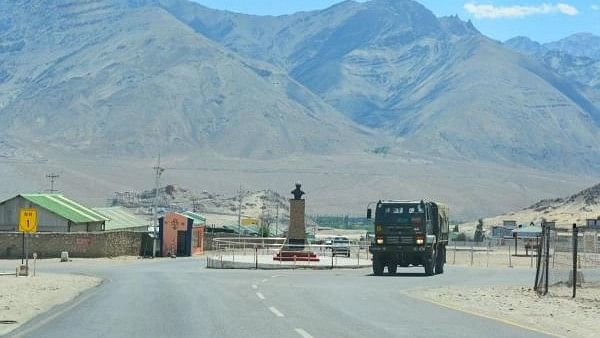
An army truck moves towards LAC, amid India-China border dispute in eastern Ladakh, in Leh. Representative image.
Credit: PTI Photo
New Delhi: The latest agreement between India and China will not end the moratorium on patrolling along the Line of Actual Control in Galwan Valley, on the northern and southern banks of Pangong Tso as well as in the Gogra and Hot Springs areas along the Line of Actual Control (LAC) in eastern Ladakh.
The agreement New Delhi and Beijing reached early on Monday will apply only to Depsang and Demchok – the two remaining points, where the four-and-a-half-year-long military stand-off between the Indian Army and the Chinese People’s Liberation Army could not be resolved in the past two years, although mutual disengagement of frontline troops from other points along the LAC had been completed before October 2022.
“What it (the new agreement between India and China) will entail is that in the pending areas under discussion patrolling and indeed grazing activities, wherever applicable, will revert to the situation as it was in 2020. And, as far as the disengagement agreements reached previously are concerned, those agreements were not reopened in these discussions,” Foreign Secretary Vikram Misri clarified on Tuesday.
“The agreement that was reached yesterday, very early yesterday morning, focussed on issues that had remained outstanding in the last couple of years,” he added, in response to a question from journalists during a briefing on Prime Minister Narendra Modi’s visit to Kazan in Russia for the 16th BRICS summit being hosted by Russian President Vladimir Putin.
Misri had on Monday announced the agreement between India and China on the arrangement for patrolling along the LAC by the Indian Army and the Chinese PLA. External Affairs Minister S Jaishankar also said on Monday that India and China had gone back to where the situation had been in 2020 and the process of disengagement of troops had been completed.
The breakthrough in the protracted negotiations between the two sides set the stage for Modi’s first formal bilateral meeting with President Xi Jinping since the Indian Army and the Chinese PLA had got engaged in a stand-off along the de facto boundary between the two nations in eastern Ladakh in April-May 2020.
The foreign secretary told journalists in Kazan on Tuesday that Modi and Xi would hold a bilateral meeting on the sideline of the BRICS summit on Wednesday.
Though protracted negotiations led to the mutual withdrawal of frontline troops by both the Indian Army and the Chinese PLA from Galwan Valley, northern and southern banks of Pangong Tso, Gogra Post, and Hot Springs by September 2022, the negotiation to resolve the stand-off in Depsang and Demchok remained stalled over the past 24 months.
The PLA troops deployed in Depsang, well inside the territory of India along the LAC with China, continued to block the Indian Army’s access to Patrolling Points 10, 11, 12, 12A, and 13. A similar stand-off also continued in Demchok.
The agreement New Delhi and Beijing reached on Monday would allow the Indian Army troops to patrol in and around Depsang and Demchok as they had been doing before the Chinese PLA’s aggressive moves in April-May 2020. The deal would also allow the local farmers to go for cattle grazing in the areas.
The new agreement, however, would not end the patrolling moratorium that the Indian Army and the Chinese PLA had mutually agreed upon while creating a three-kilometer-long (about 1.5 kilometres on both sides) “buffer zone” in Galwan Valley on July 6, 2020, just days after the violent face-off between the soldiers of the two sides in the area.
The Indian Army had earlier regularly sent soldiers from its permanent base at the Dhan Singh Thapa Post near Finger 3 on the northern bank of Pangong Tso (lake) for patrolling up to Finger 8. But it had to suspend patrolling after a scuffle between its troops and the Chinese PLA soldiers near Finger 4 in May 2020. The PLA had later built bunkers and observation posts and deployed additional troops in the area – thus denying access to the Indian Army to its earlier patrolling limit at Finger 8.
The February 2021 deal, however, had created an eight-kilometer-long buffer zone between Finger 3 and Finger 8 on India’s side of the LAC with China (on Pangong Tso northern bank), with a moratorium on patrolling by both sides.
The new agreement will also not allow the Indian Army troops to go back to the pre-April-May-2020 patrolling pattern neither on the northern and southern banks of Pangong Tso nor on Gogra and Hotsprings areas, where both sides had mutually pulled out troops in August 2021 and September 2022 respectively, after creating similar ‘buffer zones’ and agreeing on the moratorium on patrolling.
